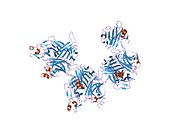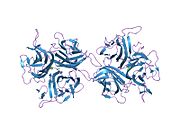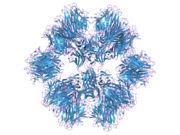| TNFSF13B |
|---|
 |
|
| Identifiers |
|---|
| Aliases |
TNFSF13B, BAFF, BLYS, CD257, DTL, TALL-1, TALL1, THANK, TNFSF20, ZTNF4, TNLG7A, tumor necrosis factor superfamily member 13b, TNF superfamily member 13b |
| External IDs |
OMIM: 603969 MGI: 1344376 HomoloGene: 48443 GeneCards: TNFSF13B |
|
| Gene location (Mouse) |
|---|
 |
| Chr. |
Chromosome 8 (mouse) |
|
| Band |
8 A1.1|8 4.55 cM |
Start |
10,056,467 bp |
| End |
10,089,072 bp |
|
|
|
|
| Wikidata |
|
B-cell activating factor (BAFF) also known as tumor necrosis factor ligand superfamily member 13B and CD257 among other names, is a protein that in humans is encoded by the TNFSF13B gene. BAFF is also known as B Lymphocyte Stimulator (BLyS) and TNF- and APOL-related leukocyte expressed ligand (TALL-1) and the Dendritic cell-derived TNF-like molecule (CD257 antigen; cluster of differentiation 257).
Structure and function
BAFF is a cytokine that belongs to the tumor necrosis factor (TNF) ligand family. This cytokine is a ligand for receptors TNFRSF13B/TACI, TNFRSF17/BCMA, and TNFRSF13C/BAFF-R. This cytokine is expressed in B cell lineage cells, and acts as a potent B cell activator. It has been also shown to play an important role in the proliferation and differentiation of B cells.
BAFF is a 285-amino acid long peptide glycoprotein which undergoes glycosylation at residue 124. It is expressed as a membrane-bound type II transmembrane protein on various cell types including monocytes, dendritic cells and bone marrow stromal cells. The transmembrane form can be cleaved from the membrane, generating a soluble protein fragment. BAFF steady-state concentrations depend on B cells and also on the expression of BAFF-binding receptors. BAFF is the natural ligand of three nonconventional tumor necrosis factor receptors named BAFF-R (BR3), TACI (transmembrane activator and calcium modulator and cyclophilin ligand interactor), and BCMA (B-cell maturation antigen), all of which have differing binding affinities for it. These receptors are expressed mainly on mature B lymphocytes and their expression varies in dependence of B cell maturation (TACI is also found on a subset of T-cells and BCMA on plasma cells). BAFF-R is involved in the positive regulation during B cell development. TACI binds worst since its affinity is higher for a protein similar to BAFF, called a proliferation-inducing ligand (APRIL). BCMA displays an intermediate binding phenotype and will work with either BAFF or APRIL to varying degrees. Signaling through BAFF-R and BCMA stimulates B lymphocytes to undergo proliferation and to counter apoptosis. All these ligands act as homotrimers (i.e. three of the same molecule) interacting with homotrimeric receptors, although BAFF has been known to be active as either a hetero- or homotrimer (can aggregate into 60-mer depending on the primary structure of the protein).
Interactions
B-cell activating factor has been shown to interact with TNFRSF13B,TNFSF13,TNFRSF13C, and TNFRSF17.
Interaction between BAFF and BAFF-R activates classical and noncanonical NF-κB signaling pathways. This interaction triggers signals essential for the formation and maintenance of B cell, thus it is important for a B-cell survival.
Recombinant production
Human BLyS has been expressed and purified in E. Coli. The BLyS protein in the engineered bacteria can be as much as 50% to the bacteria's total protein content and still retains activity after a purification procedure.
Clinical significance
As an immunostimulant, BAFF (BLyS, TALL-1) is necessary for maintaining normal immunity. Inadequate level of BAFF will fail to activate B cells to produce enough immunoglobulin and will lead to immunodeficiency.
Excessive level of BAFF causes abnormally high antibody production, results in systemic lupus erythematosus, rheumatoid arthritis, and many other autoimmune diseases. Overexpression of BAFF also correlates with enhanced humoral immunity against malaria infection.
Belimumab (Benlysta) is a monoclonal antibody developed by Human Genome Sciences and GlaxoSmithKline, with significant discovery input by Cambridge Antibody Technology, which specifically recognizes and inhibits the biological activity of B-Lymphocyte stimulator (BLyS) and is in clinical trials for treatment of Systemic lupus erythematosus and other autoimmune diseases.
BAFF has been found in renal transplant biopsies with acute rejection and correlate with appearance C4d. Increased levels of BAFF may initiate alloreactive B cell and T cell immunity, therefore may promote allograft rejection. Lower level of BAFF transcripts (or a higher level of soluble BAFF) show a higher risk of producing donor-specific antibodies in the investigated patients. Donor-specific antibodies bind with high affinity to the vascular endothelium of graft and activate complement. This process result in neutrophils infiltration, hemorrhage, fibrin deposition and platelet aggregation. Targeting BAFF-R interactions may provide new therapeutic possibilities in transplantation.
Blisibimod, a fusion protein inhibitor of BAFF, is in development by Anthera Pharmaceuticals, also primarily for the treatment of systemic lupus erythematosus.
BAFF may also be a new mediator of food-related inflammation. Higher levels of BAFF are present in non-atopic compared with atopic patients, and there is not any correlation between BAFF and IgE, suggesting that BAFF might be particularly involved in non-IgE-mediated reactions. In patients with celiac disease, serum BAFF levels are reduced after a gluten-free diet. The same reduction could be present in the recently defined “Non Celiac Gluten sensitivity” (a reaction to gluten which provokes almost the same symptoms of celiac disease and could involve up to 20% of apparently healthy individuals.) BAFF is also a specific inducer of insulin resistance and can be a strong link between inflammation and diabetes or obesity. BAFF gives the organism a sort of danger signal and usually, according to the evolutionary theories, every human being responds to danger activating thrifty genes in order to store fat and to avoid starvation. BAFF shares many activities with PAF (Platelet Activating Factor) and they are both markers of non-IgE-mediated reactions in food-reactivity.
Further reading
-
Nardelli B, Moore PA, Li Y, Hilbert DM (July 2002). "B lymphocyte stimulator (BLyS): a therapeutic trichotomy for the treatment of B lymphocyte diseases". Leukemia & Lymphoma. 43 (7): 1367–73. doi:10.1080/10428190290033297. PMID 12389615. S2CID 2521553.
-
Zhou T, Zhang J, Carter R, Kimberly R (2003). "BLyS and B cell autoimmunity". B Cell Biology in Autoimmunity. Current Directions in Autoimmunity. Vol. 6. pp. 21–37. doi:10.1159/000066854. ISBN 978-3-8055-7454-9. PMID 12408045.
-
Stohl W (2005). "A therapeutic role for BLyS antagonists". Lupus. 13 (5): 317–22. doi:10.1191/0961203304lu1019oa. PMID 15230285. S2CID 40631500.
-
Quartuccio L, Fabris M, Ferraccioli G (2004). "[B lymphocyte stimulator (BLyS) and monocytes: possible role in autoimmune diseases with a particular reference to rheumatoid arthritis]". Reumatismo. 56 (3): 143–6. doi:10.4081/reumatismo.2004.143. PMID 15470519.
-
Sutherland AP, Mackay F, Mackay CR (December 2006). "Targeting BAFF: immunomodulation for autoimmune diseases and lymphomas". Pharmacology & Therapeutics. 112 (3): 774–86. doi:10.1016/j.pharmthera.2006.06.002. PMID 16863659.
-
Bossen C, Schneider P (October 2006). "BAFF, APRIL and their receptors: structure, function and signaling" (PDF). Seminars in Immunology. 18 (5): 263–75. doi:10.1016/j.smim.2006.04.006. PMID 16914324.
-
Brink R (October 2006). "Regulation of B cell self-tolerance by BAFF". Seminars in Immunology. 18 (5): 276–83. doi:10.1016/j.smim.2006.04.003. PMID 16916609.
-
Tangye SG, Bryant VL, Cuss AK, Good KL (October 2006). "BAFF, APRIL and human B cell disorders". Seminars in Immunology. 18 (5): 305–17. doi:10.1016/j.smim.2006.04.004. PMID 16916610.
-
Treml LS, Crowley JE, Cancro MP (October 2006). "BLyS receptor signatures resolve homeostatically independent compartments among naïve and antigen-experienced B cells". Seminars in Immunology. 18 (5): 297–304. doi:10.1016/j.smim.2006.07.001. PMID 16919470.
-
Woodland RT, Schmidt MR, Thompson CB (October 2006). "BLyS and B cell homeostasis". Seminars in Immunology. 18 (5): 318–26. doi:10.1016/j.smim.2006.06.001. PMID 16931037.
-
Kalled SL (October 2006). "Impact of the BAFF/BR3 axis on B cell survival, germinal center maintenance and antibody production". Seminars in Immunology. 18 (5): 290–6. doi:10.1016/j.smim.2006.06.002. PMID 16931038.
-
Mackay F, Leung H (October 2006). "The role of the BAFF/APRIL system on T cell function". Seminars in Immunology. 18 (5): 284–9. doi:10.1016/j.smim.2006.04.005. PMID 16931039.
-
Bosello S, Pers JO, Rochas C, Devauchelle V, De Santis M, Daridon C, Saraux A, Ferraccioli GF, Youinou P (2007). "BAFF and rheumatic autoimmune disorders: implications for disease management and therapy". International Journal of Immunopathology and Pharmacology. 20 (1): 1–8. doi:10.1177/039463200702000101. PMID 17346422. S2CID 46295467.
-
Mukhopadhyay A, Ni J, Zhai Y, Yu GL, Aggarwal BB (June 1999). "Identification and characterization of a novel cytokine, THANK, a TNF homologue that activates apoptosis, nuclear factor-kappaB, and c-Jun NH2-terminal kinase". The Journal of Biological Chemistry. 274 (23): 15978–81. doi:10.1074/jbc.274.23.15978. PMID 10347144.
-
Moore PA, Belvedere O, Orr A, Pieri K, LaFleur DW, Feng P, Soppet D, Charters M, Gentz R, Parmelee D, Li Y, Galperina O, Giri J, Roschke V, Nardelli B, Carrell J, Sosnovtseva S, Greenfield W, Ruben SM, Olsen HS, Fikes J, Hilbert DM (July 1999). "BLyS: member of the tumor necrosis factor family and B lymphocyte stimulator". Science. 285 (5425): 260–3. doi:10.1126/science.285.5425.260. PMID 10398604.
-
Tribouley C, Wallroth M, Chan V, Paliard X, Fang E, Lamson G, Pot D, Escobedo J, Williams LT (December 1999). "Characterization of a new member of the TNF family expressed on antigen presenting cells". Biological Chemistry. 380 (12): 1443–7. doi:10.1515/BC.1999.186. PMID 10661873. S2CID 26187605.
-
Gross JA, Johnston J, Mudri S, Enselman R, Dillon SR, Madden K, Xu W, Parrish-Novak J, Foster D, Lofton-Day C, Moore M, Littau A, Grossman A, Haugen H, Foley K, Blumberg H, Harrison K, Kindsvogel W, Clegg CH (April 2000). "TACI and BCMA are receptors for a TNF homologue implicated in B-cell autoimmune disease". Nature. 404 (6781): 995–9. Bibcode:2000Natur.404..995G. doi:10.1038/35010115. PMID 10801128. S2CID 4323357.
-
Shu HB, Johnson H (August 2000). "B cell maturation protein is a receptor for the tumor necrosis factor family member TALL-1". Proceedings of the National Academy of Sciences of the United States of America. 97 (16): 9156–61. Bibcode:2000PNAS...97.9156S. doi:10.1073/pnas.160213497. PMC 16838. PMID 10908663.
External links
|
PDB gallery
|
|---|
1jh5: Crystal Structure of sTALL-1 of TNF family ligand
1kd7: Crystal structure of an extracellular domain fragment of human BAFF
1kxg: The 2.0 Ang Resolution Structure of BLyS, B Lymphocyte Stimulator.
1oqd: Crystal structure of sTALL-1 and BCMA
1oqe: Crystal structure of sTALL-1 with BAFF-R
1osg: Complex between BAFF and a BR3 derived peptide presented in a beta-hairpin scaffold
1otz: Crystal structure of the BAFF-BAFF-R complex (part I)
|
|
|
|---|
| 1–50 |
|
| 51–100 |
|
| 101–150 |
|
| 151–200 |
|
| 201–250 |
|
| 251–300 |
|
| 301–350 |
|
|
|
|---|
| By family |
|
By function/
cell |
|
|
|
|---|
| Chemokine |
|
| CSF |
|
| Interferon |
| IFNAR (α/β, I) |
-
Agonists: Albinterferon
- Interferon alpha (interferon alfa, IFN-α)
-
Interferon alfa (IFNA1, IFNA2, IFNA4, IFNA5, IFNA6, IFNA7, IFNA8, IFNA10, IFNA13, IFNA14, IFNA16, IFNA17, IFNA21)
- Interferon alfa 2a
- Interferon alfa 2b
- Interferon alfa n1
- Interferon alfacon-1
- Interferon alpha-n3
-
Interferon beta (IFN-β) (IFNB1, IFNB3)
- Interferon beta 1a
- Interferon beta 1b
- Interferon kappa (IFN-ε/κ/τ/ζ, IFNK)
- Interferon omega (IFN-ω, IFNW1)
- Peginterferon alfa-2a
- Peginterferon alfa-2b
|
| IFNGR (γ, II) |
|
| IFNLR (λ, III) |
- See IL-28R (IFNLR) here instead.
|
|
| Interleukin |
|
| TGFβ |
|
| TNF |
|
| Others |
|












